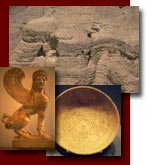| Site Map | Contacts | Links | Newsletter | |
Biblical Archaeology:
Garden of Eden
In order to locate Eden one must understand the ancient words being used. The "source" or "head" of the river is what we would call the "mouth" of the river (Hess & Tsumura, 1994, 178-9). Therefore all four rivers would empty into the Persian gulf. The Tigris and Euphrates rivers are easy to locate. Speiser identifies the possibilities of the other two as the Gihon=Diyala, Kirkha, or Kerkha and Psihon=Kerkha, Karun, or Wadi er-Rumma respectively (Ibid., 181, Map and more information at Lecture 3: Ancient Mesopotamia). If Gihon is identified with Kerkha, then the rivers of Eden are listed in an east to west direction, and the Pishon would be the Karun river in Elam. If Eridu may be equated with Eden then the Garden would be just east of Eridu where a branch canal produced abundant crops (Fischer 1996, 222). It should be noted that back then the Persian gulf would have been extended all the way back to Eridu and Ur.
There is another new identification of the river Pishon with the Wadi Batin that was seen from satellite photos. Wadi Batin is a dried up river, but at one time it would have connected with the Tigris and Euphrates Rivers. See Has the Garden of Eden been located at last? for photos and details. This is a very good possibility. The Gihon would then be identified with the Karun river in Elam.
Some think the Hebrew word "Eden" is from the Sumerian word "edin" meaning "plain" and its Akkadian equivalent is edinu (Fischer 1996, 223) which refers to the land between the Trigris and Euphrates Rivers.
Other scholars equate the garden of Eden with the similar description of ancient Dilmun. See Tombs of Dilmun . Dilum was probably the island Bahrain in the Persian gulf. There is a Sumerian story entitled Enki and Ninhursag which describes a paradise similar to Eden only it is called Dilmun. It says:
The land Dilmun is pure, the land Dilmun is clean; The land Dilmun is clean, the land Dilmun is most bright. In Dilmun the raven utters no cries, The ittidu-bird utters no the cry of the ittidu-bird, The lion kills not, The wolf snatches not the lamb, The sick-eyed says not "I am sick-eyed," The sick-headed (says) not "I am sick-headed," Its old woman (says) not "I am an old woman," Its old man (says) not "I am an old man," He filled the dikes with water, He filled the ditches with water, He filled the uncultivated places with water. The gardener in the dust in his joy (ANET 1969, 38-9).
The geography surrounding Eden seems to be the same before the flood as well as after the flood. The same rivers and mountains are mentioned. This seems to indicate that Noah’s flood was local. There is an excellent article on this by John Munday Jr entitled Eden’s Geography Erodes Flood Geology (Westminster Theological Journal 58:1. 123-44, 1996).
